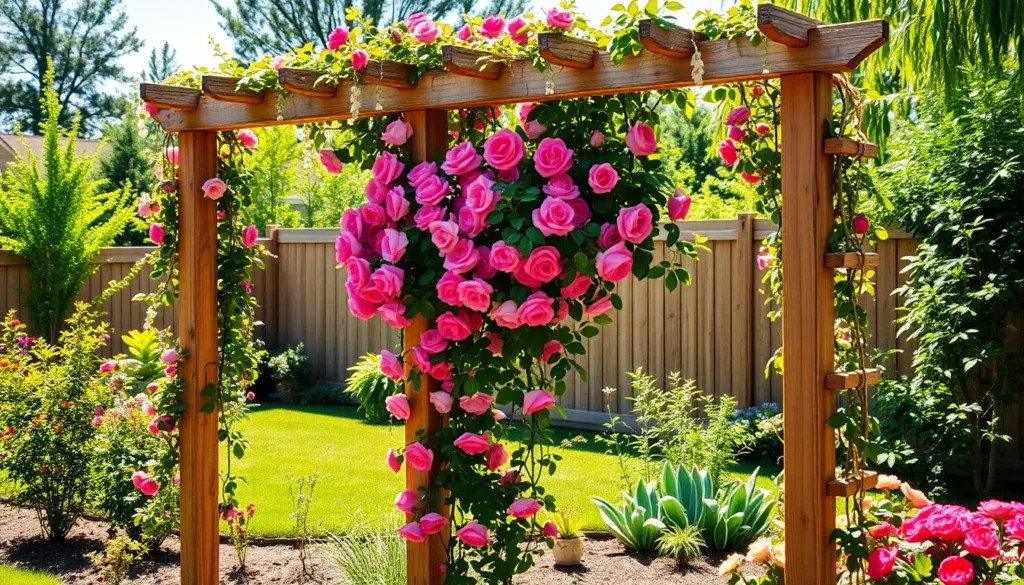Transforming your garden with stunning trellis structures doesn’t have to expensive or require professional installation. We’ve discovered that the right trellis can turn any boring fence line or empty wall into a thriving vertical paradise that’ll make your neighbors green with envy.
Whether you’re dealing with limited space or simply want to maximize your growing potential, creative trellis answers offer endless possibilities. From rustic DIY projects using reclaimed materials to sleek modern designs that complement contemporary landscapes, we’ll show you how to choose and build the perfect support system for your climbing plants.
Ready to elevate your gardening game? We’ve compiled the most innovative and practical trellis ideas that work for every skill level and budget. These versatile structures not only provide essential plant support but also create stunning focal points that add height, texture, and visual interest to any outdoor space.
Wooden Trellis Designs for Classic Garden Appeal
Wood remains the most popular choice for garden trellises due to its natural beauty and versatility. These timeless designs complement any garden style while providing sturdy support for your climbing plants.
Traditional Lattice Panels
Traditional lattice panels offer the perfect balance of elegance and functionality for your garden trellis needs. We recommend using standard 4×8 foot panels made from pressure-treated lumber that can withstand weather exposure for 10-15 years. Diamond patterns create the most popular lattice design, with 2-inch openings that provide ideal support for roses, clematis, and jasmine vines.
Installing these panels requires minimal tools and can be completed in under 2 hours per section. We suggest mounting them on sturdy posts spaced 6-8 feet apart for maximum stability. The classic white finish remains the top choice among homeowners, though natural cedar tones are gaining popularity for their organic appeal.
Pre-made lattice panels cost between $25-60 each at most home improvement stores. Custom sizes can be ordered for unique spaces, typically adding 20-30% to the base price. We’ve found that painting these panels every 3-4 years maintains their appearance and extends their lifespan significantly.
Rustic Branch and Twig Structures
Rustic branch structures bring natural woodland charm to any garden space while costing virtually nothing to create. We collect fallen branches from oak, maple, and birch trees during late fall when they’re most abundant. These organic materials create unique patterns that can’t be replicated with manufactured products.
Building these trellises requires branches ranging from 1-3 inches in diameter for the main framework. We use smaller twigs and flexible shoots to weave horizontal supports between the vertical posts. Natural jute twine or hemp rope works best for securing connections without creating unsightly metal hardware.
The construction process takes 2-3 hours per 4-foot section depending on design complexity. We recommend harvesting branches during dormant seasons to ensure they’re free from insects and disease. These structures typically last 3-5 years before needing replacement, making them perfect for annual climbing vegetables like beans and cucumbers.
Weather-resistant species like cedar and locust branches extend the lifespan to 6-8 years. We often combine different wood types to create interesting color contrasts and textures throughout the growing season.
Cedar and Pine Options
Cedar trellis options provide exceptional durability and natural pest resistance for long-term garden installations. We prefer Western Red Cedar for its straight grain and consistent quality, though Eastern White Cedar offers similar benefits at lower costs. These materials naturally resist rot and insect damage for 15-20 years without chemical treatments.
Pine alternatives deliver excellent value for budget-conscious gardeners while maintaining attractive appearance. We recommend pressure-treated Southern Yellow Pine for its strength and affordability, typically costing 40-50% less than cedar options. The lighter weight makes pine easier to handle during installation and repositioning.
Both species accept stains and paints exceptionally well, allowing for custom color matching with existing garden structures. We’ve achieved beautiful results using semi-transparent stains that highlight the natural wood grain while providing UV protection. Clear sealers work best for maintaining the natural appearance while preventing weathering.
Construction techniques remain similar for both materials, though cedar requires pre-drilling to prevent splitting. We use stainless steel hardware for all cedar projects to prevent unsightly staining from rust. Pine installations can use standard galvanized fasteners without cosmetic concerns.
Metal Trellis Solutions for Modern Gardens
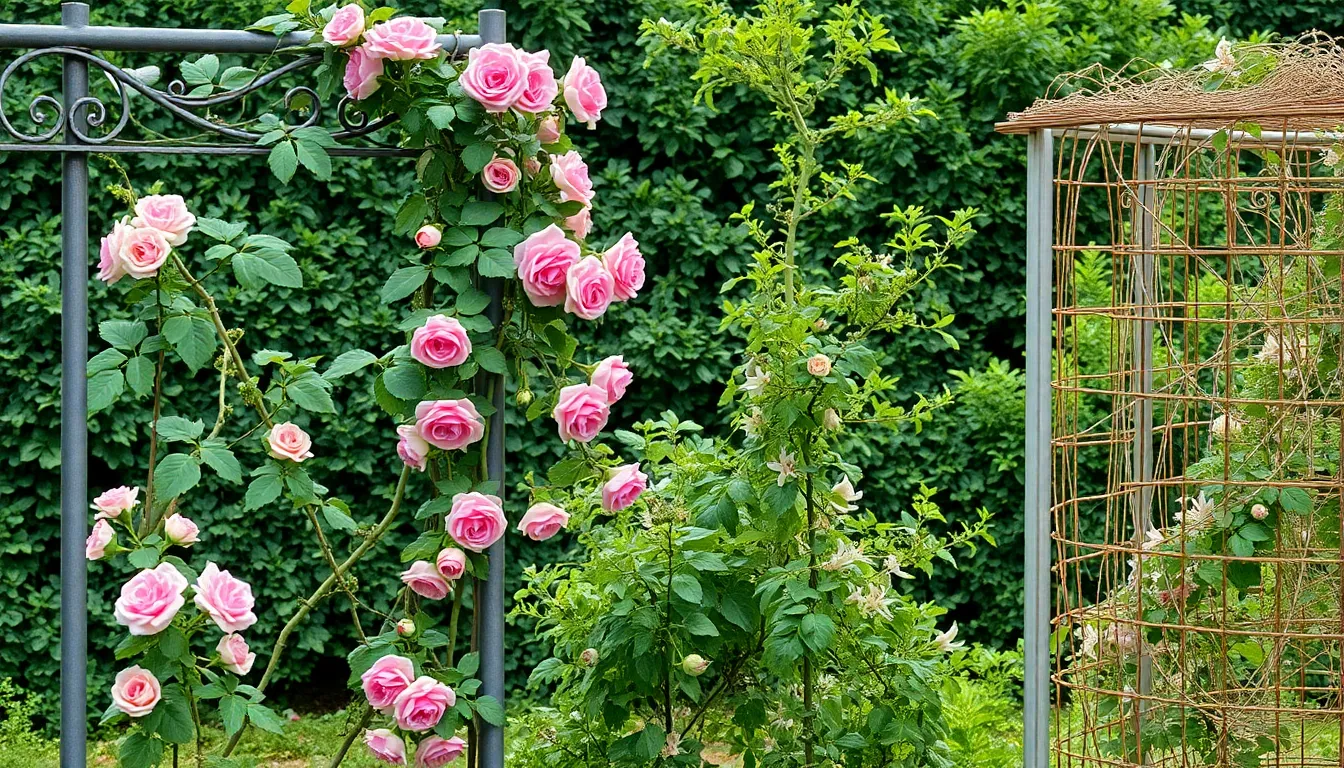
Metal trellises elevate garden design with their exceptional durability and sophisticated aesthetic appeal. We’ve identified three outstanding metal options that perfectly complement contemporary outdoor spaces.
Wrought Iron Decorative Panels
Wrought iron trellises deliver timeless elegance while providing robust support for climbing plants in modern gardens. These decorative panels feature intricate scrollwork and artistic motifs that transform functional plant support into stunning garden art. Durability stands out as their primary advantage, with weather-resistant properties that withstand harsh conditions year after year.
Installation options include standalone screens, wall-mounted configurations, and fence integration to create vertical interest and enhanced privacy. Climbing plants like roses, clematis, and jasmine thrive on these sturdy structures, using the decorative ironwork as natural anchoring points. Visual impact combines with practical functionality, making wrought iron panels ideal focal points that support heavy flowering vines.
Galvanized Steel Grid Systems
Galvanized steel trellises offer minimalist design with industrial strength that perfectly suits contemporary garden aesthetics. The geometric grid pattern creates clean lines while the galvanization process prevents rust, ensuring longevity in humid or rainy climates. Versatility defines these systems through multiple installation methods including vertical wall mounting, freestanding panels, and raised bed integration.
Plant training becomes effortless with the open grid structure, accommodating beans, peas, and flowering vines while maintaining an airy appearance. Tiered growing areas emerge when combining these systems with raised beds, maximizing vertical space for both vegetables and flowers. Maintenance requirements remain minimal due to the rust resistant coating and straightforward design.
Copper Wire Frameworks
Copper wire trellises provide artistic elegance through their unique aging process that develops a beautiful green patina over time. This natural weathering creates a distinctive appearance that complements garden greenery while maintaining structural integrity. Custom shapes become possible with copper’s malleable properties, allowing for panels, arches, and organic designs that suit exact garden layouts.
Plant support ranges from delicate clematis to heavier grapevines, with the copper framework adapting to various climbing habits and weights. Garden applications include entryways, espaliered fruit trees, and standalone supports that combine horticultural function with artistic expression. Low maintenance requirements and exceptional durability make copper wire frameworks a long term investment in both beauty and plant support.
DIY Trellis Projects Using Recycled Materials
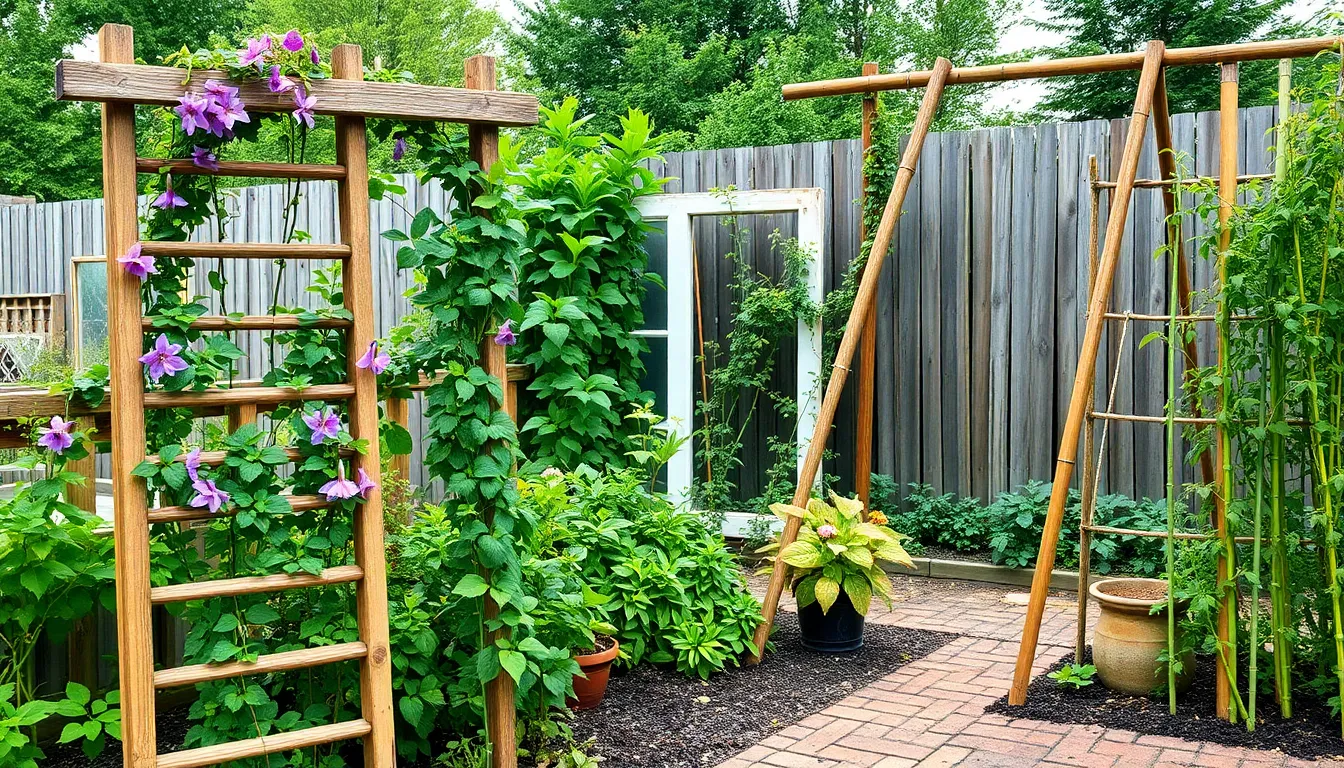
We can transform everyday discarded items into stunning garden supports while reducing waste. These eco-friendly alternatives offer unique character that’s impossible to achieve with store-bought options.
Repurposed Ladder Trellises
Old ladders make exceptional trellises when leaned against walls or fences at strategic angles. We position them to create rustic vertical gardens that support climbing plants like clematis or jasmine beautifully. The rungs naturally provide perfect spacing for plant attachment, while the weathered wood adds authentic charm to any outdoor space.
Installation requires minimal effort since we simply secure the base and attach plants using wire or twine. The ladder’s built-in structure eliminates complex measuring or cutting that other DIY projects demand. Most importantly, this approach works exceptionally well in small gardens where space efficiency matters most.
Old Window Frame Structures
Window frames create elegant trellis foundations that bring architectural interest to boring fence lines. We attach these frames directly to walls or existing structures, then add wire mesh or lattice backing for climbing plant support. The glass panes can remain intact for decorative purposes or be removed to create open growing spaces.
These structures work particularly well for lighter climbing plants that don’t require heavy-duty support systems. We often source frames from renovation projects or salvage yards, making this an incredibly budget-friendly option. The installation process involves basic screwing and wire attachment, requiring no specialized tools or advanced skills.
Bamboo Pole Constructions
Bamboo poles offer versatile trellis answers that we can arrange in teepee styles or structured frames depending on garden needs. These natural materials support climbing plants like peas or beans while maintaining an organic aesthetic that complements most garden designs. The lightweight nature makes repositioning easy as seasonal growing patterns change.
We secure poles together using twine or wire, creating custom configurations that fit exact spaces perfectly. This flexibility allows us to build tall structures for vigorous climbers or shorter supports for delicate plants. The construction process requires no power tools, making it accessible for gardeners of all skill levels while maintaining durability throughout growing seasons.
Vertical Growing Systems for Small Spaces
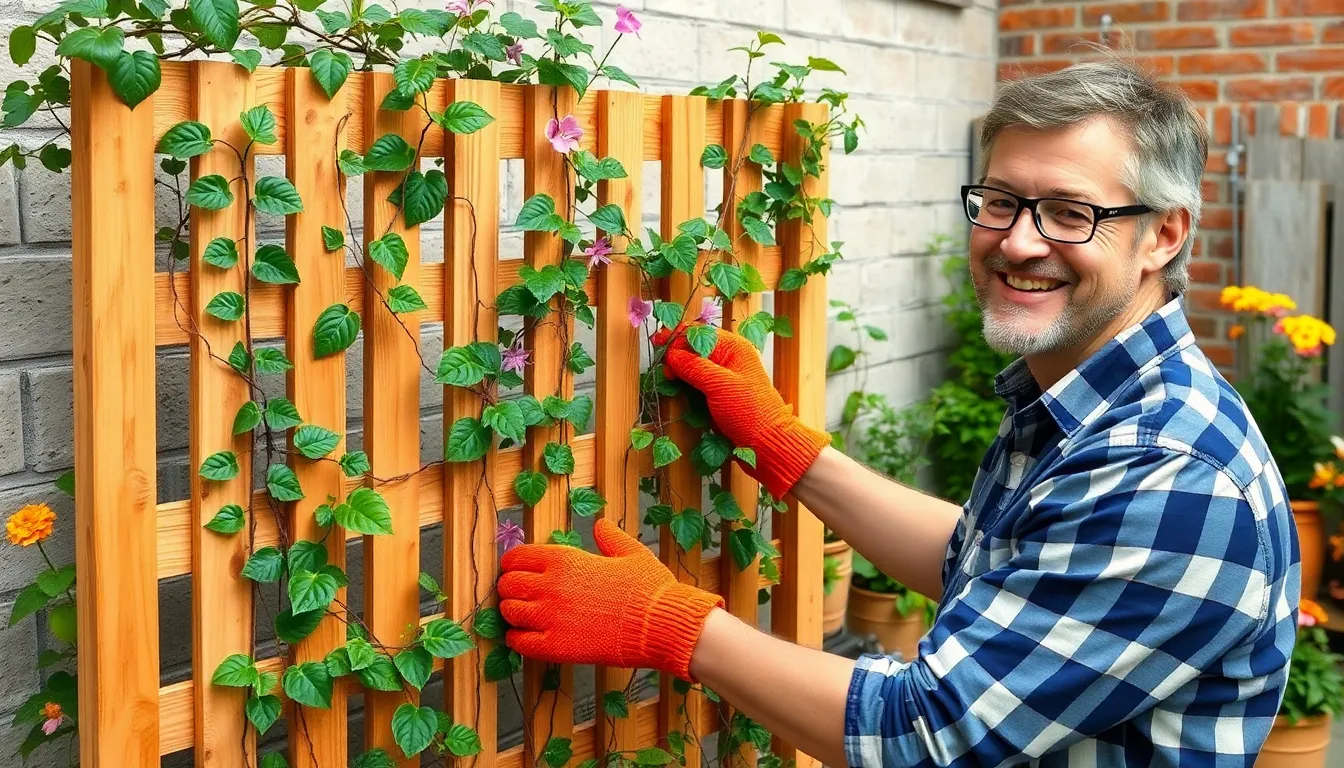
Small gardens don’t have to limit your growing potential when you maximize every inch of available space with smart vertical answers.
Wall-Mounted Trellis Ideas
Wire mesh trellises transform bare walls into productive growing surfaces for climbing plants like ivy or clematis. We recommend securing galvanized wire mesh panels directly to exterior walls using heavy-duty screws and wall anchors for maximum stability. These systems work exceptionally well for apartment balconies and narrow side yards where ground space is precious.
PVC pipe grid systems offer an affordable alternative that’s perfect for renters who can’t make permanent modifications. Create custom-sized grids by connecting PVC pipes with elbow joints and securing them to walls with removable mounting brackets. We’ve found that 1-inch diameter pipes provide excellent support for lightweight climbing vegetables like peas and beans.
Wooden slat panels bring natural warmth to wall-mounted growing systems while supporting heavier climbing plants. Install cedar or pressure-treated lumber slats horizontally with 6-inch spacing to create a ladder-like structure that’s ideal for tomatoes and cucumbers.
Freestanding Tower Designs
Trellis teepees constructed from wooden dowels or metal stakes create stunning vertical focal points while supporting climbing plants like peas or beans. We suggest using 8-foot stakes arranged in a circle with 3-4 foot diameter base for optimal plant coverage and stability. These structures work beautifully in container gardens and raised beds.
Garden arbors serve dual purposes as both plant supports and architectural features that define garden spaces. Freestanding arbor designs provide generous growing space for larger climbing plants while creating natural walkways and shade areas. We recommend choosing arbors with 7-8 foot height clearance for comfortable passage.
Cylindrical tower trellises maximize growing potential in minimal footprint areas using wire mesh formed into columns. Create these towers by rolling hardware cloth into 18-24 inch diameter cylinders and filling the center with compost for continuous plant nutrition.
Corner Trellis Answers
L-shaped trellis frames fit perfectly into garden corners while providing substantial growing surface for plants like clematis or climbing roses. We design these structures using two perpendicular panels joined at 90-degree angles for maximum corner utilization. These configurations work exceptionally well in raised bed corners and fence intersections.
Corner triangular supports create unique growing environments using three poles arranged in triangular formation. Position poles at equal distances from the corner point and connect them with horizontal support wires or netting for climbing plant attachment.
Wraparound corner systems follow the natural corner contours using flexible materials like bamboo or wire mesh. These designs allow plants to climb around corners naturally while providing continuous support from multiple angles.
Creative Trellis Shapes and Artistic Designs
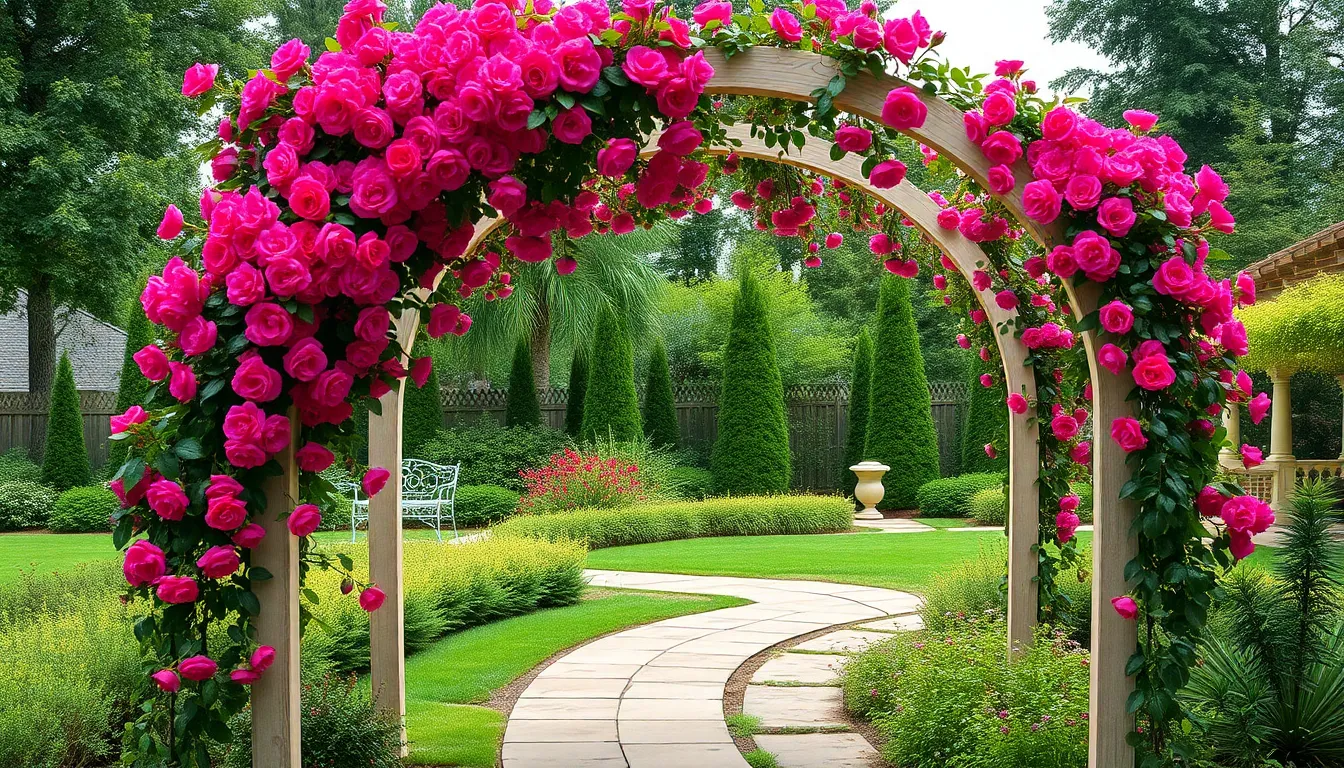
Transforming our gardens into works of art requires thinking beyond traditional flat panels. Unique trellis shapes serve as functional sculptures that support climbing plants while creating stunning focal points throughout our outdoor spaces.
Arched Garden Entrances
Cottage arbor trellises create inviting entrances that welcome visitors into our garden spaces. These classic arched structures work perfectly for training climbing roses, jasmine, and other flowering vines that frame doorways and pathways with natural beauty.
Curved walkway trellises define garden pathways while adding vertical interest to our industry design. We can install these arched structures to create romantic tunnels of greenery, transforming ordinary garden paths into enchanting outdoor corridors.
Gateway arbors serve dual purposes as both decorative elements and practical plant supports. These structures mark transitions between different garden areas, creating natural room dividers that guide visitors through our outdoor spaces.
Geometric Pattern Structures
Espaliered fruit trellises train branches to grow flat against walls in precise geometric patterns. This technique creates living artwork while maximizing fruit production in small spaces, combining functionality with visual appeal.
Tiered garden beds with lattice trellises add dimensional layers to our planting areas. These structured designs support climbing vegetables and flowers while creating organized growing zones that maximize our garden’s productive potential.
Diamond pattern frameworks offer contemporary styling that complements modern garden designs. We can construct these angular structures using metal or wood materials, creating bold geometric statements that support various climbing plants.
Living Wall Trellis Systems
Wall mounted trellis panels transform blank walls into productive growing surfaces. These space saving answers work perfectly for apartment balconies and small patios, creating privacy screens while maximizing our vertical gardening opportunities.
Wire lattice systems cover unsightly walls with lush greenery, creating urban jungle effects in confined spaces. Simple backyard installations can hide utility areas or fence lines while providing support for fast growing vines and climbing vegetables.
Modular living wall frameworks allow us to customize our vertical gardens based on available space. These flexible systems expand as our gardening needs grow, accommodating everything from herb gardens to flowering displays.
Plant-Specific Trellis Recommendations
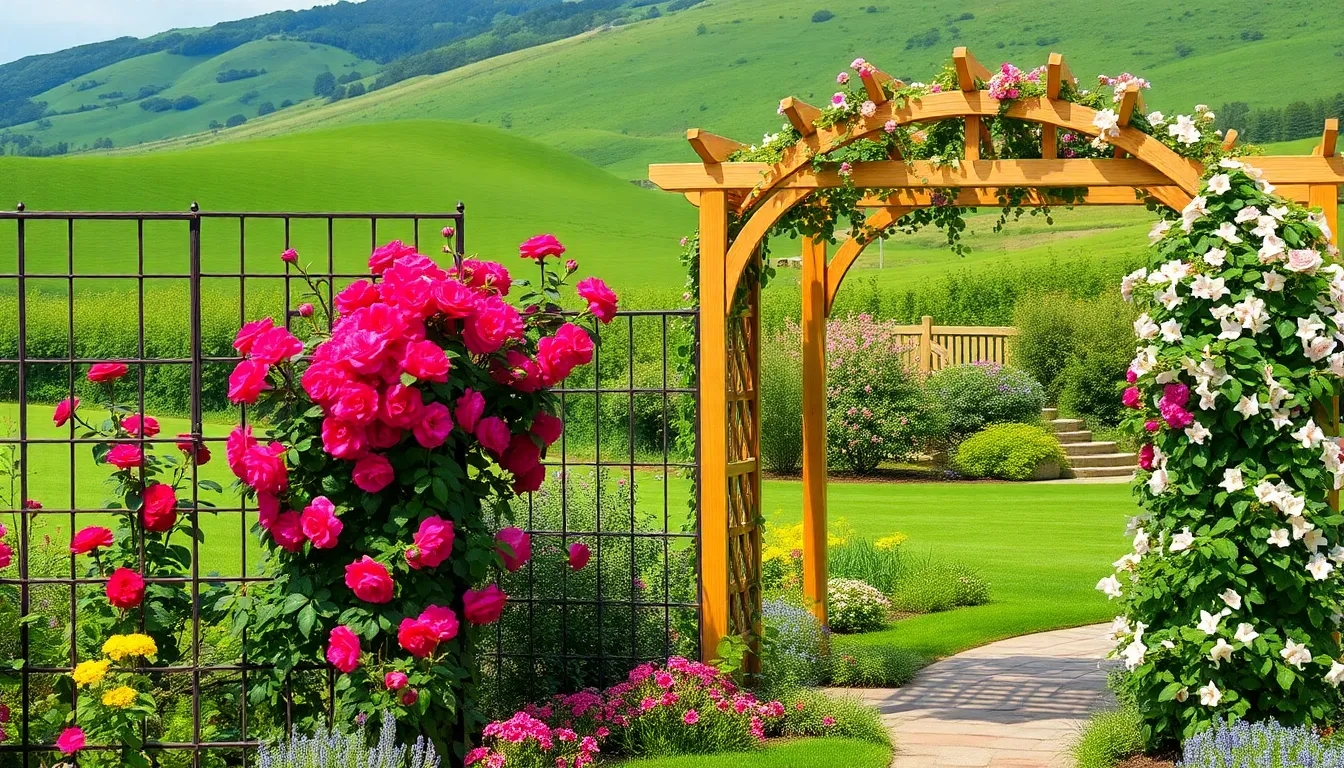
Selecting the right trellis design for your exact plants ensures optimal growth and stunning visual impact. Different climbing plants have unique support requirements that determine which trellis style will work best in your garden.
Vine and Climbing Rose Supports
Metal trellises provide the sturdy foundation that climbing roses and vigorous vines like ivy or clematis need to thrive. These durable structures handle the weight of mature climbing roses with their thick canes and abundant blooms without bending or breaking.
Wooden latticework offers another excellent option for rose supports, creating an aesthetically pleasing backdrop that complements traditional garden designs. We recommend using pressure treated lumber for longevity, especially when supporting heavy climbing varieties like ‘Eden’ or ‘New Dawn’ roses.
Wrought iron panels work exceptionally well for established climbing roses, as their decorative patterns provide multiple attachment points for training canes. The robust construction supports even the most vigorous climbers like ‘Lady Banks’ rose, which can reach heights of 20 feet or more.
Vegetable Garden Trellis Options
Expandable trellis fences maximize growing space in vegetable gardens while providing adjustable support for climbing crops like peas, beans, and cucumbers. These flexible systems can be extended from 4 to 8 feet wide, accommodating different planting layouts throughout the growing season.
Wall mounted trellises work perfectly against garage walls or fence lines, supporting pole beans and sugar snap peas while keeping vegetables off the ground. We’ve found that mounting these trellises 6 inches from the wall allows proper air circulation and prevents pest problems.
Galvanized steel grid systems offer the strength needed for heavy producing vegetables like indeterminate tomatoes and winter squash. Their modular design lets you connect multiple panels to create custom sized growing areas that match your garden’s exact dimensions.
Flowering Climber Frameworks
Arched trellises create stunning focal points when supporting flowering climbers like jasmine, honeysuckle, or sweet peas. These curved structures frame garden entrances and pathways while providing the overhead support that encourages abundant blooming.
Living trellises using natural branches offer an organic approach for delicate flowering climbers like morning glories or nasturtiums. We recommend using freshly cut willow or birch branches, which maintain flexibility while providing the gentle support these tender climbers prefer.
Pergola style frameworks accommodate multiple flowering climbers simultaneously, creating layered displays of color and fragrance throughout the growing season. These substantial structures support vigorous growers like climbing hydrangeas and trumpet vines while providing partial shade beneath.
Seasonal Trellis Maintenance and Care Tips
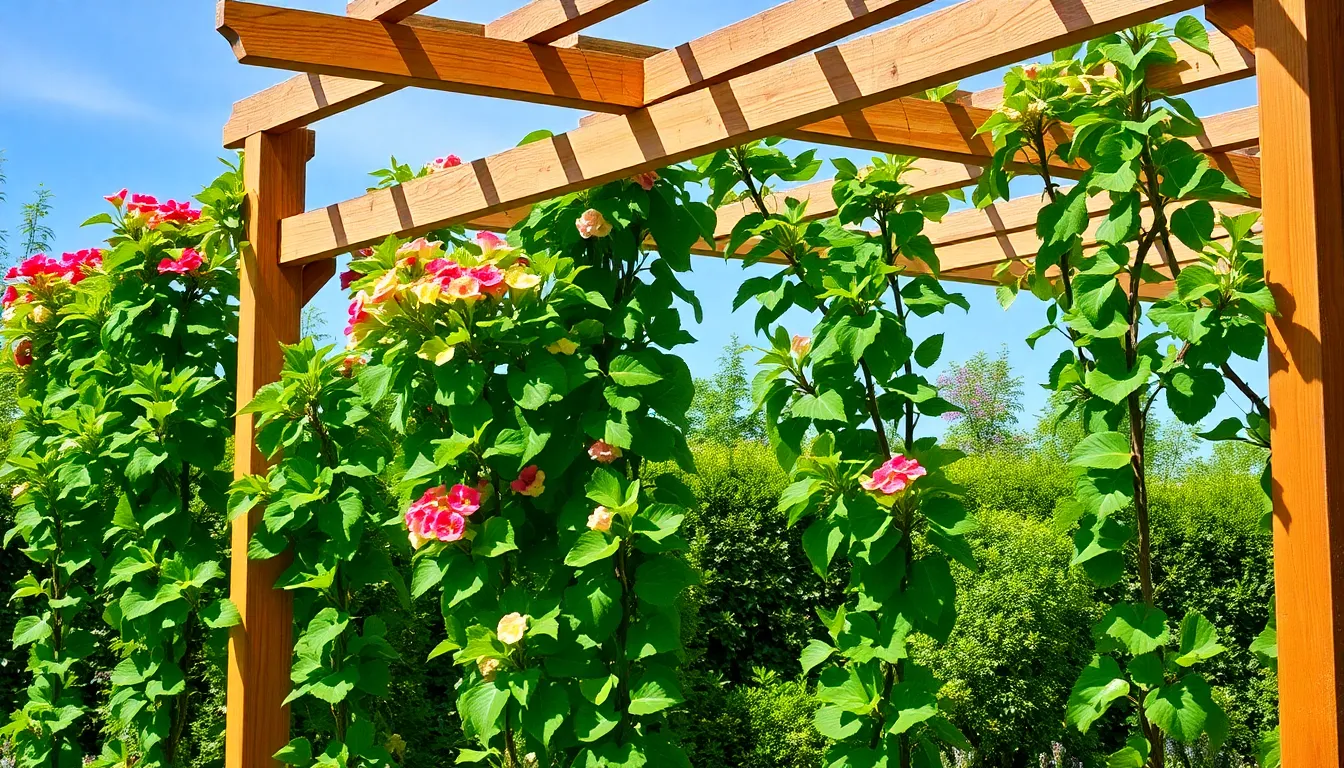
Proper maintenance throughout the year ensures our trellis structures remain functional and beautiful while supporting healthy plant growth. Strategic seasonal care extends the life of our garden investments and maximizes growing potential.
Spring Setup and Installation
Install trellises early in spring before new growth begins to provide adequate support as plants emerge from dormancy. This timing allows climbing plants to establish strong growth patterns and receive optimal sunlight throughout the growing season.
Position structures carefully by placing them in locations that match each plant’s exact light requirements and growth habits. Most climbing plants thrive with morning sun and afternoon protection from harsh rays.
Prune old dead material thoroughly to prevent disease spread and encourage vigorous new growth. Remove all winter damaged stems and clean debris from around the base of the trellis structure.
Check structural integrity by examining all connections, joints, and anchor points for winter damage or loosening. Replace damaged hardware and tighten loose bolts before plants begin their climbing journey.
Summer Plant Training Techniques
Train vines regularly using soft string or wire to gently guide stems up the trellis structure. This technique maximizes vertical space and promotes healthy air circulation between branches.
Secure growing tips to trellis points every few inches as plants develop to prevent wind damage and maintain desired growth direction. Use plant ties that won’t cut into stems as they thicken.
Prune strategically throughout summer to maintain shape and encourage continuous flowering or fruiting. Remove suckers, damaged growth, and overcrowded branches to keep plants productive.
Monitor plant weight distribution across the trellis to prevent structural overload, especially with heavy producing vegetables like tomatoes or squash. Add additional support ties as needed.
Winter Storage and Protection
Remove all debris thoroughly by cleaning dead plant material from the trellis structure to prevent disease overwintering and pest habitat formation. This step improves next season’s plant health significantly.
Store lightweight materials in protected areas like garages or sheds to prevent weather damage from snow loads or ice formation. Bamboo and plastic trellises benefit most from indoor winter storage.
Secure permanent structures by checking that wooden and metal trellises remain anchored properly against winter wind loads. Add additional bracing if structures show movement or stress.
Apply protective treatments to wooden trellises using weather resistant stains or sealers before harsh weather arrives. This maintenance extends material life and prevents rot or insect damage.
Conclusion
We’ve explored countless ways to transform your garden with stunning trellis structures that’ll support your climbing plants while adding visual drama to your outdoor space. From budget-friendly DIY projects using recycled materials to elegant metal frameworks these versatile answers work for every garden size and style.
The key to success lies in matching your trellis choice to your exact plants’ needs and your garden’s aesthetic. Whether you’re growing vegetables on a balcony or creating a living wall with flowering vines the right trellis makes all the difference.
Remember that proper maintenance keeps your trellis looking beautiful and functioning effectively for years to come. With these ideas and techniques you’re ready to create vertical gardens that’ll be the envy of your neighborhood.
Frequently Asked Questions
What are the most affordable DIY trellis options for small gardens?
Repurposed ladders, old window frames, and bamboo poles offer excellent budget-friendly solutions. Fallen branches can be crafted into rustic twig structures at virtually no cost. These recycled materials not only save money but also add unique character to your garden while promoting environmental sustainability.
How do I choose between wooden and metal trellis structures?
Wooden trellises offer natural charm and are easier to customize, with cedar providing durability and pine offering budget-friendly options. Metal trellises, including wrought iron and galvanized steel, provide superior strength and longevity but cost more. Consider your budget, aesthetic preferences, and the weight of plants you’ll support.
What trellis designs work best for climbing roses and heavy vines?
Metal trellises, particularly wrought iron decorative panels and galvanized steel grid systems, provide the robust support needed for vigorous climbers like roses. These structures can handle substantial weight while offering intricate designs that complement flowering plants beautifully.
How can I maximize vertical growing space on a small balcony?
Wall-mounted wire mesh panels, PVC pipe grids, and wooden slat systems are ideal for apartment balconies. Freestanding tower designs like trellis teepees maximize growing space without requiring wall attachment, making them perfect for renters or temporary setups.
What’s the best way to maintain my trellis throughout the seasons?
Spring maintenance includes checking structural integrity and pruning plants. Summer requires regular plant training and ensuring proper air circulation. Winter care involves cleaning debris, securing structures against weather, and applying protective treatments to wooden trellises to extend their lifespan.
Are there trellis options specifically designed for vegetable gardens?
Yes, expandable trellis fences work excellently for pole beans and peas, while galvanized steel grid systems provide strong support for heavy-producing vegetables like tomatoes and cucumbers. Wall-mounted trellises are perfect for sugar snap peas and other lightweight climbing vegetables.
How do I create an artistic focal point with my trellis design?
Consider geometric patterns like espaliered fruit trellises or curved walkway designs. Arched garden entrances and gateway arbors serve as both functional plant supports and decorative architectural elements that create inviting pathways and frame garden spaces beautifully.
What materials should I avoid when building a trellis?
Avoid untreated wood in ground contact, as it will rot quickly. Skip flimsy materials that can’t support plant weight or weather conditions. Non-galvanized metal will rust rapidly outdoors. Choose pressure-treated lumber, galvanized steel, or naturally rot-resistant woods like cedar for longevity.

